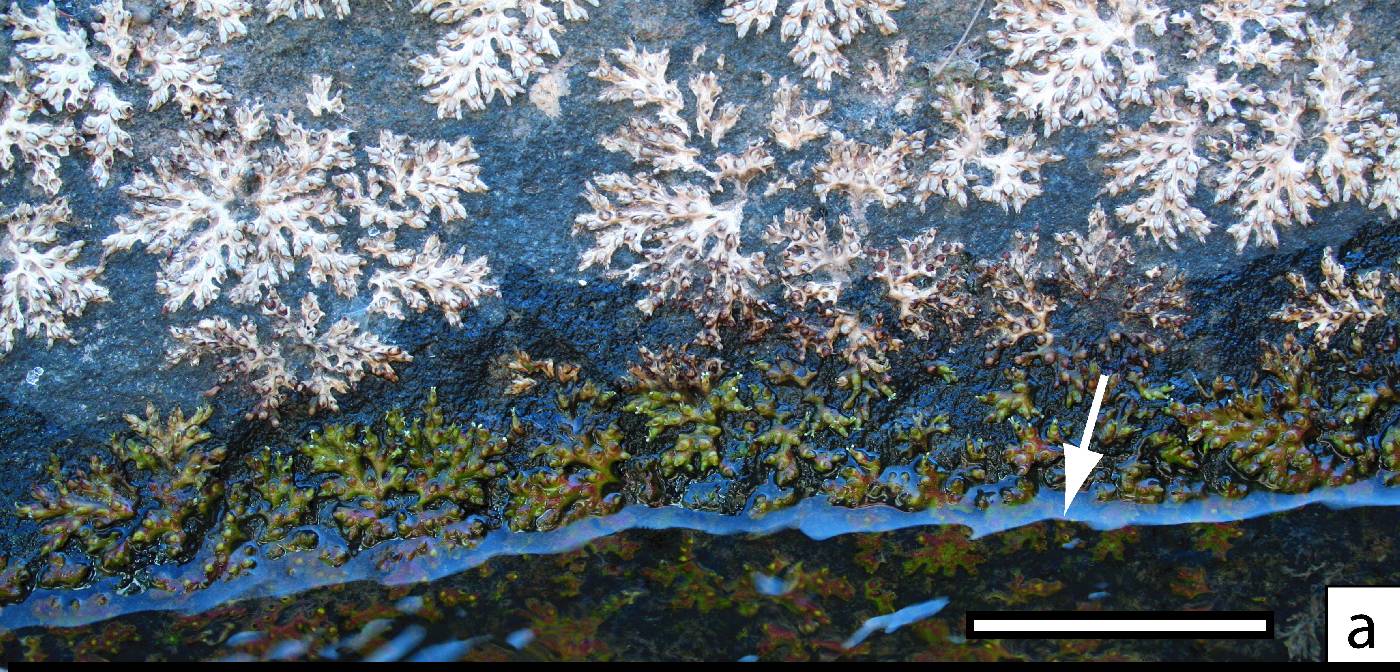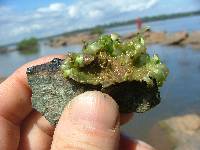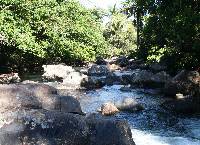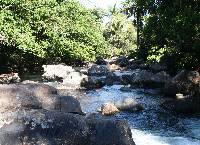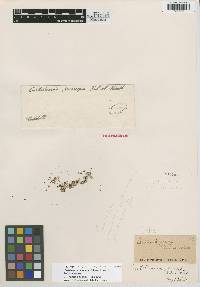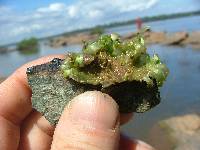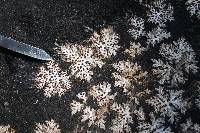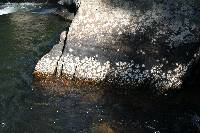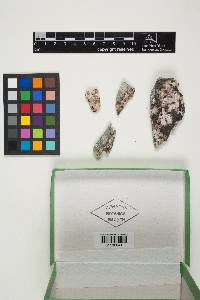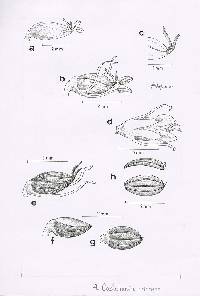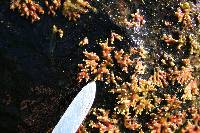
Neotropical Flora
|
Family: Podostemaceae
[Castelnavia cuneifolia van Royen] |
Herbs, often with dense growth. Stems prostrate, tightly attached to substratum throughout, cylindrical to flattened in cross-section, (0.7) 2 (45) mm wide; repeatedly dichotomously or subdichotomously branched. Leaves arising from prostrate stem margins, simple and entire, variously lobed, or pinnately compound; simple leaves linear to spatulate, (0.2) 2.1 (8.5) × (3) 11 (22) mm; pinnate leaves (0.9) 2.5 (6) × (3) 6.5 (14) cm; petiolate or petiole lacking, petiole flat in cross-section, (0.2) 0.65 (0.8) cm; rachis distinctly widened and flattened, (0.1) 2.5 (6) mm wide, (1) 3 (11) veined (at base), pinnae (2) 7.5 (50) mm, variously lobed, ultimate divisions (0.4) 1.1 (2.8) × (0.03) 0.05 (0.3) mm, linear, spatulate or triangular in outline, apex acute or obtuse, falling away as plants are exposed. Spathella (2.4) 3.9 (4.8) × (1.2) 1.5 (2.2) mm, rupturing apically or sub- apically into (7) 11 (14) linear to triangular segments. Flowers numerous, lateral on stems, each in a cavity, pedicel (0.2) 0.3 (1.4) mm prior to anthesis. Tepals (0) 2 (3), one on each side of fused stamen filaments, occasionally an additional tepal between stamen filaments, (1.3) 2.5 (3.6) mm, apex acute. Stamens 2, filaments (0.8) 1.7 (2.1) × (0.3) 0.5 (0.7) mm prior to anthesis, elongating to (1.8) 3.2 (6) and projecting from ruptured spathella during anthesis; anthers (1.2) 1.4 (1.6) × (0.8) 0.8 (0.8) mm. Pollen polar diameter (17.5) 18 (20) μm, equatorial diameter (15) 16.6 (18.7) μm, sexine 1 μm, nexine 0.8 μm. Ovary in preanthesis flowers (0.9) 1.9 (2.4) × (0.7) 1.3 (2) mm; in post anthesis flowers (1.3) 1.9 (2.2) × (0.8) 1.55 (1.9) mm; apical region of dorsal (upper) carpel lacking papil- lae. Ovules (46) 77 (261) per ovary. Stigmas (0.3) 0.8 (1.6) mm prior to anthesis, elongating to (1) 3.5 (4) mm during anthesis Capsules (1.3) 1.9 (2.7) × (1) 1.5 (2) mm; upper (dorsal) valve (1.3) 2.1 (2.7) × (0.8) 1.2 (1.7) mm, 3 ribbed (nonsuture), lacking papillae; lower (ventral) valve (1.3) 1.9 (2.7) × (0.9) 1.5 (2) mm, 3 ribbed (nonsuture). Seeds (0.17) 0.28 (0.5) × (0.1) 0.17 (0.3) mm; (0) 40 (240) per capsule. Figures 1a, d-e; 5; 7. Discussion: Dried plants often become whitened (Fig. 1a, d-e). The flabelliform growth habit is pronounced when plants are dry. Some populations lack tepals. Circumstantial evidence indicates that Castelnavia princeps inhibits the growth of other species of Castelnavia growing within several cm (allelopathy). Field observations reveal a zone of inhibition around plants of this species in some populations. Phenology: Flowering January-August. Distribution and Habitat: Castelnavia princeps is the most widespread species in the genus, occurring in Goiás, Mato Grosso, Minas Gerais, and Pará, Brazil (Fig. 9). Plants can be abundant, forming a dense carpet-like growth. Castelnavia princeps has been documented growing sympatrically (albeit beyond the zone of inhibition noted above) with other species in the genus (C. fluitans, C. monandra, C. multipartita f. multipartita) as well as species in other genera of Podostemaceae (Monostylis, Apinagia, Lonchostephus, Tristicha). Representative Specimens Examined: BRAZIL. Goiás: Uruhu River, 25 Jul 1895, Glaziou 22014 (C x2); Caiapônia, Bonito River, 51° 42’10” W, 16° 48’35” S, 10 Jul 2001, Bittrich et al. 2001/63 (UEC, WCSU). Mato Grosso: Bandeirante, Juruena River, 56° 13’45.7” W, 9° 57’2.3” S, 22 Sep 2007, Bove & Philbrick 1885 (CONN, R, WCSU); Juruena, Juruena River, 58° 20’41.7” W, 10° 22’32.1” S, 28 Sep 2007, Bove & Philbrick 1917 (CONN, R, WCSU); Idem, 58° 20’19.5” W, 10° 22’50.9” S, 28 Sep 2007, Bove & Philbrick 1918 (R, WCSU); Nobres, Nobres River, 56° 21’58.4” W, 14° 41’52.9” S, 25 Jul 2003, Bove et al. 1165 (R); Idem, 56° 21’56.4” W, 14° 41’56.1” S, 17 Jul 2006, Philbrick et al. 5963, 5966 (R, WCSU). Minas Gerais: Aiuruoca, Capitinga River, 22 Jun 2000, Bove et al. 725, 726 (R, WCSU); Idem, Papagaio River, 1 Jan 2005, Paz & Luz 150, 494 (R); Idem, Matutu Valley, Capitinga River, 5 Mar 2000, Bove 689 (R); Aiuruoca-Alagoa, Aiuruoca River, 25 Jun 2000, Bove et al. 728 (R, WCSU); Baependi, Gamarra River, 20 Jan 2006, Ferreira 1040, 1123 (R); Caldas, Jan 1901, Regnell III 2053 (C x2); Idem, Verde River, 25 Apr 1874, Mosén 1694 (L); Idem, Capivary River, 10 May 1874, Mosén 1695 (L); Idem, 2 Jun 1865, Regnell III 1117 (L); Idem, Regnell III 1114 (C, U); Cardeal Mota, Cipó River, 43° 38’24” W, 19° 20’50.5” S, 8 Jul 2001, Philbrick & Novelo 5715 (MEXU, WCSU); Morro do Pilar, 43° 23’45.7” W, 19° 14’24.1” S, 24 Jul 2002, Philbrick & Novelo 5716 (MEXU, WCSU); Idem, Picao River, 43° 23’13.6” W, 19° 14’6” S, 24 Jul 2002, Philbrick & Novelo 5718 (WCSU); Rio Bugres, Regnell 2053 (C x4). Pará: Jacareacanga, São Benedito River, 56° 35’7.3” W, 9° 3’11.5” S, 18 Sep 2007, Bove & Philbrick 1864 (R, WCSU); São João do Araguaia, Araguaia River, 48° 55’34.2” W, 5° 18’28.5” S, 22 Jul 2006, Philbrick et al. 5977 (R, WCSU); Idem, 48° 55’43” W, 5° 18’20” S, 13 Jun 2005, Philbrick et al. 5850 (MEXU, R, WCSU). |
Powered by Symbiota.

